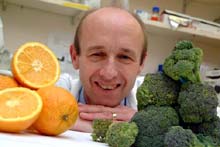
Novel developments in electronics which are giving ecologists important new tools to quickly and easily measure biodiversity will be described at the British Ecological Society’s Winter Meeting, being held at the University of York on 18–20 December 2002.
Speaking at the meeting, electronics expert and entomologist Dr David Chesmore from the University of York will explain a novel method of identifying different grasshopper species using time domain signal coding and artificial neural netwo

Selective Estrogen Receptor Modulators (SERMs) Eliminate Risk of Breast Cancer Associated with Hormone Replacement Therapy But Preserve Many Health Benefits of Estrogen
Tissue-Specific Estrogenic and Antiestrogenic Activity of SERMs Provide Opportunities for Individualized Treatment of Menopause-related Adverse Symptoms, Health Risks and Diseases
As scientific evidence mounts linking Hormone Replacement Therapy (HRT) to breast cancer and other illnesses, a class of d

The science minister, Lord Sainsbury, will today open the highest resolution analytical microscope in the world at the CCLRC Daresbury Laboratory in Cheshire. The SuperSTEM (Scanning Transmission Electron Microscope) project is directed by Professor Peter Goodhew at Liverpool University and involves other scientists from the Universities of Liverpool, Cambridge, Glasgow and Leeds.
The microscope is housed in a new purpose-built low-vibration laboratory at the Daresbury Laboratory and will

Procedure could reduce side effects and enhance potency of anti-cancer drugs
Cancer patients undergoing chemotherapy often endure painful side effects caused by the powerful drugs as they course through their entire bodies, damaging healthy tissue and tumors alike.
Brigham Young University researchers are reporting in the December issue of the prestigious oncology journal “Cancer Research” that they have successfully tested a new method in laboratory animals that would conc

Southampton scientists are hoping to find out why some people benefit more than others from the effects of fruit and vegetables in battling conditions such as rheumatoid arthritis, inflammatory bowel disease, asthma and heart disease.
It is already known that a diet rich in fruit, vegetables, nuts and tea provides plenty of antioxidants such as vitamins E and C, beta-carotene and polyphenols. These help tackle an excess of free radicals and oxidants produced to help our immune system kill ha

ESA’s gamma-ray satellite, Integral, is fully operational. Today Integral’s first ground-breaking images of the high-energy Universe were presented in Paris, France. Astronomers call such initial observations ’first-light’ images.
The high-energy Universe is a violent place of exploding stars and their collapsed remnants such as the ultra-compressed neutron stars and, at the most extreme, all-consuming black holes. These celestial objects create X-rays and gamma rays tha

– new calculation confirms standard model of particle physics. Contribution of hadronic vacuum polarization determined with unprecedented accuracy. The magnetic moment of the muon is an important precision parameter for…
Technique may prevent formation of unwanted waves that siphon off needed energy. Heating plasma to the ultra-high temperatures needed for fusion reactions requires more than turning the dial on a…

An international team of astronomers, led by researchers from the Astronomical Observatory of the University of Warsaw, have identified a new class of cosmic X-ray sources. The findings have been…

Antibody that Neutralizes Inhibitory Factors Involved in Nerve Regeneration Leads to Enhanced Motor Function after Acute Spinal Cord Injury. Researchers at 13 clinics in Germany, Switzerland, the Czech Republic and…

How the body’s natural killer cells could fight leukemia. Every year, some 13,000 people in Germany are diagnosed with leukemia. Despite intensive chemotherapy, around one in two of them die….

… eco-friendly reactor converts air and water into ammonia. Producing enough ammonia to feed the world comes with a large carbon footprint;. process described in new UB-led study could help…

How simulations help manufacturing of modern displays. Modern materials must be recyclable and sustainable. Consumer electronics is no exception, with organic light-emitting diodes (OLEDs) taking over modern televisions and portable…

“Neurons that fire together, wire together” describes the neural plasticity seen in human brains, but neurons grown in a dish don’t seem to follow these rules. Neurons that are cultured…

The quest for sustainable energy solutions has been a major focus of scientific research for decades. Solar energy, a clean and renewable source, has emerged as a promising alternative to…

With a processing speed a billion times faster than nature, chip-based laser neuron could help advance AI tasks such as pattern recognition and sequence prediction. Researchers have developed a laser-based…

New technology could remotely identify various types of plastics, offering a valuable tool for future monitoring and analysis of oceanic plastic pollution. Researchers have developed a new hyperspectral Raman imaging…

Artificial Intelligence (AI) has established a strong presence across industries, large and small. The “VoBaKI” research project has empowered small and medium-sized enterprises (SMEs) with an innovative tool to independently…